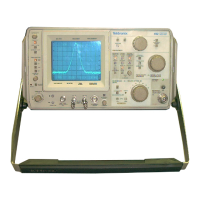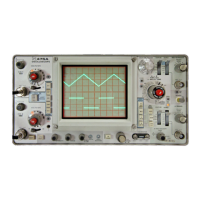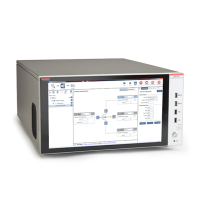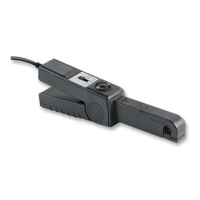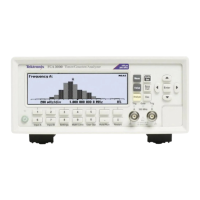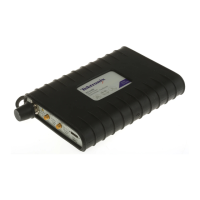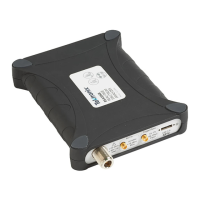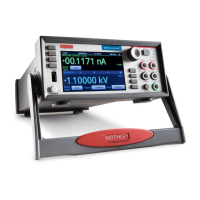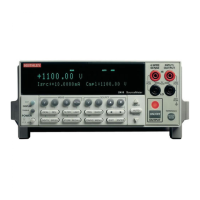12. Tune the signal to the extreme left graticule line with
the RF CENTER FREQUENCY control. Note the dial reading.
Tune the signal to the extreme right graticule line and note
the dial reading. The difference between dial readings is
the total dispersion window for this 10 division display. Tune
the signal to the center of the screen and switch the DIS-
PERSION-COUPLED RESOLUTION selector to the 5 MHz/
div position. Tune the signal across the screen and note
the total dispersion. It should decrease to approximately
½ the dispersion noted with the DISPERSION selector in
the 10 MHz/div position. Tune the signal to the center of
the screen.
13. Tune the IF CENTER FREQ coarse control through its
range. Note that all signals move across the screen in the
same direction and the same amount. This control shifts
the IF center frequency approximately + and - 25 MHz
with the DISPERSION controls in this position. Tune the IF
CENTER FREQ control to center the signal on the screen.
14. Change the DISPERSION selector to .5 MHz/div.
Adjust the FINE (1 turn) IF CENTER FREQ control. Note the
frequency range of this control. This control shifts the IF
center frequency approximately + and - 1 MHz with the
DISPERSION RANGE in this position.
15. Change the TIME/DIV switch between .1 s and .1 ms
positions. Note the change in signal amplitude and the
resolution. Return the TIME/DIV selector to the 10 ms posi-
tion.
16. Push the LOCK CHECK button and tune the RF CENTER
FREQUENCY control very carefully through the signal fre-
quency. Note the phase lock beat signals between the tun-
able local oscillator and the Internal Reference Frequency
oscillator as the display blooms, then snaps into phase lock
operation (Fig. 2-13).
17. With the LOCK CHECK button depressed, adjust the
FINE RF CENTER FREQ control. Note the beat frequency dis-
plays as the control is varied, and note also the vertical shift
of the baseline. This baseline shift is the change in the out-
put DC level of the phase amplifier. Note the zero beat sig-
nal compression at the extreme positions of this control com-
pared to their amplitude near the center. Phase lock should
be set with the output DC level within the center 4 divisions
of the graticule. Adjust for phase lock operation and re-
lease the LOCK CHECK button.
18. Switch the DISPERSION RANGE switch to kHz/DIV,
then decrease the DISPERSION TO 20 kHz/div, keeping the
signal centered on screen with the IF CENTER FREQ con-
trol. Slowly rotate the FINE RF CENTER FREQ control. Note
the positive action of the phase lock circuit before lock is
lost. Return the signal to its locked mode by adjusting the
FINE RF CENTER FREQ control.
19. Uncouple the RESOLUTION and turn the control
clockwise. Note that the signal broadens as the resolu-
tion bandwidth is increased. The resolution may be varied
from approximately 1 kHz to 100 kHz, Return the RESOLU-
TION control to the coupled position.
20. Adjust the INTENSIFIER control through its range. This
control suppresses the base of the display, and can be
utilized when photographing displays at slow sweep rates.
See Operation of the INTENSIFIER control. It should be left
in the OFF position for most aperating situations.
GENERAL OPERATING INFORMATION
Light Filters
The instrument is shipped with a mesh filter installed.
Two (2) colored filters, plus a clear CRT faceplate protector
and an ornamental ring are provided with the accessories.
The mesh filter improves the contrast when viewing the
display under high ambient light conditions. The blue and
yellow filters can be used to take advantage of the dual
phosphor characteristics of the P7 CRT.
The mesh filter is removed by pressing down at the bot-
tom of the frame and pulling the top of the holder away
from the CRT faceplate. See Fig. 2-5. To install the colored
filters, press them into the ornamental mounting ring until
they snap behind the retainer lips. To remove the filters
from their holder, press them out to the rear.
Fig. 2-5. Removing the light filter or faceplate.
One of the filters or protector should be used at all times
to protect the faceplate of the CRT from scratches.
Intensity Level, Astigmatism and Focus
Operate the instrument with the intensity level no higher
than the level required to clearly observe the display.
Changing the INTENSITY setting may require refocusing the
display.
The ASTIGMATISM and FOCUS controls both affect dis-
play definition and are normally adjusted together. If the
ASTIGMATISM control is correctly set, the vertical and hori-
zontal segments of the display will focus at the same posi-
tion of the FOCUS control, The controls are adjusted as
follows:
1. Obtain a display on the analyzer with both horizontal
and vertical information.
2. Adjust the ASTIGMATISM control for equally focused
vertical and horizontal portions in the display.
2-7

